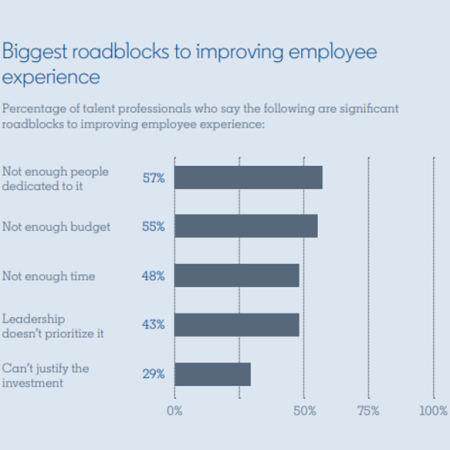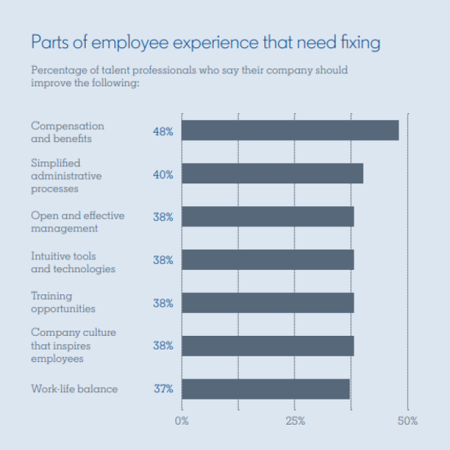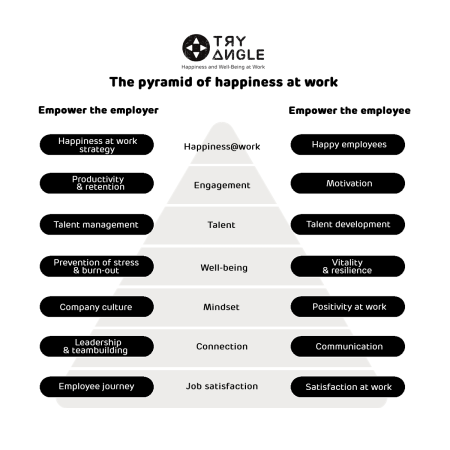 English
EnglishEmployee experience:
Your company will work for your employees, not the other way around
The Global Talent Report 2020 leaves no room for doubt. The importance of employee experience (EX) as a focal point for HR professionals is definitely beyond dispute. More importantly, I agree that improving the EX is not a stand-alone objective, but rather a means to an end in order to achieve a more important goal within the organization: employees who feel good about themselves, who are committed, who can put their talents to good use and who contribute in a meaningful way … In short, employees who are happy at work.
What about the return?
The ROI of EX, well-being at work, happiness at work – you name it – is also undeniable, as the numbers and ample case studies being conducted all over the world make a clear case. Despite all these statistics, irrefutably proving its value and significant returns, the Global Talent Report still shows 29% of HR and talent professionals indicating they cannot justify the investment and 43% reporting EX is not a priority according to leadership.
This mismatch between intentions and reality can be explained by the short-term thinking trap. Despite the theme being deemed important, there is quite some room for improvement as many organizations still leave opportunities unexploited using excuses such as no time, no money and no people. That paints a gloomy picture knowing that you can already make a world of difference by taking small steps and starting off with a very limited budget.
It’s expensive and it doesn’t work anyway
As Chief Happiness, I meet a lot of entrepreneurs, CEOs, HR professionals … who (want to) work on happiness at work and EX, but most of the time don’t really know how to go about it. It’s striking to see how often expensive initiatives are being rolled out, only to conclude afterwards that they didn’t have any impact. One of the more common examples we’ve seen is the one where the hotshot fitness room is left virtually unused. I remember the fancy relax corner with premium leather massage seats that were so shiny you needed sunglasses. The CEO didn’t consider the situation quite that sunny, as day after day, he witnessed the expensive armchairs remaining empty and thought that was a real shame. In addition to superfluous splurges like these, I asked him how often he himself had already used this cozy corner, noting that it was situated right across his office. “I haven’t,” he stated, “because I have better things to do!” Lo and behold, an unfortunate, but accurate example of “leadership not prioritizing” an how not to “lead by example” …


4Ps or rather 5?
The definition of EX is “everything an employee observes, feels, and interacts with as a part of their company”. But exactly how do you deal with “everything”? That’s only feasible by dividing it up into a number of key areas to then tackle every single one.
The LinkedIn Global Talent Report names these 4Ps of Employee Experience:
- People: relationships with co-workers, managers and leadership, as well as customer and supplier contacts
- Place: the physical work space, flexible work options and work life balance
- Product: the job content, how stimulating and meaningful it is and its fit with the employee’s talents
- Process: the values, norms and rules on how the work gets done and is rewarded, next to the implemented tools and technology
We could have a closer look at each P and complain about the current status, or we can remain optimistic and investigate some of the opportunities, for example within the “Process” area. Taking a closer look at organizational values, we see that companies are investing time to define their mission and vision and are creating a beautiful compilation of values that are then written in shiny letters across meeting room walls. These values, unfortunately, often become “part of the furniture”: seen by everyone, lived by few. I experienced it first hand during an interview with a management team member, who was asked to give some tangible examples to explain the company’s values. His face turned red as he stammered: “What words did we choose again? I should have another look at that” …
As we are in the process of considering EX in practice here, I would like to add a 5th P to the mix. One that can make it all a bit easier than it might appear at first sight. I.e. the P of “Presence” or the human point of view. Simply making room for the human aspect where colleagues can get to know each other, managers are genuinely interested in their team members and ask what their plans are during the weekend, and where HR knows your name instead of your badge number. Consider working from a talent perspective at team level, fully aware that this can only work if managers are actually acquainted with the talents of their team members.
As a line manager, dare to choose an authentic and coaching approach rather than just focusing on taking the lead. The human aspect in an organization is also cultivated by looking at the person behind the job title and putting a similar approach at the center of a recruitment decision, as well as making it possible for employees to grow and move through the organization based on intrinsic motivation and meaning. Presence can be created both from a strategic and an operational perspective, but unfortunately, the result-driven priorities of an organization often push the human factor to the side. Add the new ways of working to a manager’s reality, resulting in more people working from home, and you can feel the burning need for that fifth P.
There’s work to do
Looking at the most important components of EX that need urgent fixing, these are some of the topics that stand out in the eyes of this Chief Happiness:
- The need for open and effective management
- The request for more work-life balance
- The need for an inspiring company culture


Coincidentally (although there’s no such thing as a coincidence, if you ask me), Tryangle has developed a pyramid model to support companies on their way to more well-being, more engagement and more happiness at work. Or in short, the pyramid for EX (HX in Tryangle terms, i.e. Happiness Experience).
The needs that emerge from the 2020 Global Talent Report have a clear link to different layers of the Tryangle pyramid. At the very foundation, EX starts (and unfortunately often ends!) with “job satisfaction”, meaning that employees should be, amongst other things, compensated correctly and fairly for their time and that there are tools and techniques in place that provide the necessary support in order to get the job done. Next to that, the need for open and effective management is about “connection” and leadership. The demand for more work-life balance fits within the employee’s search for more “well-being” and resilience. The need for an inspiring corporate culture transcends the layer of “mindset” and, in addition to providing a positivity atmosphere at work, urges companies to push further and develop into a meaningful work environment, hence aiming for overall “happiness at work”.


Tryangle developed this pyramid to demonstrate that employers, supervisors as well as employees have a shared responsibility to deliver a great EX. After all, it’s not just the employer that is responsible for a happy experience. I often refer to this in my keynotes, stating that “I can give my cat dog food, but that doesn’t mean she will start barking”. Feel free to call it my personal version of “he that is born a fool …”. I hope you can sense the energetic enthusiasm of this happy Chief Happiness, who has seen the relevance of her mission confirmed once more. Let’s stand strong together for more well-being, happiness and EX at work!

